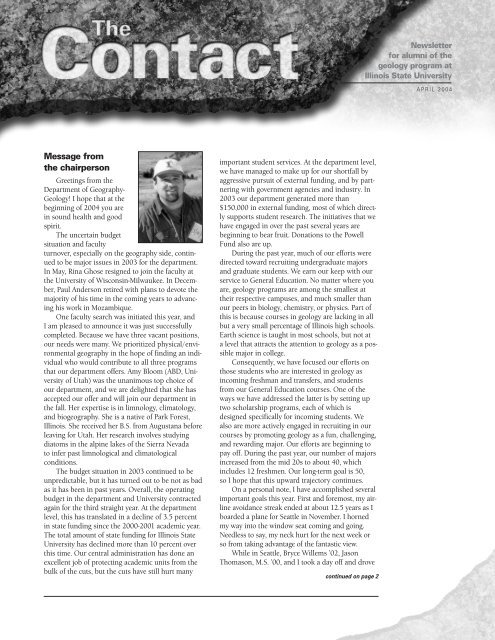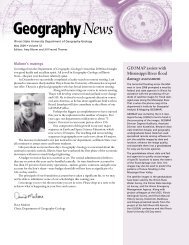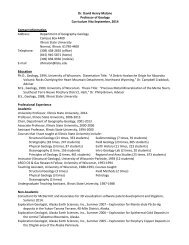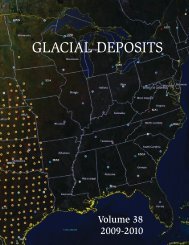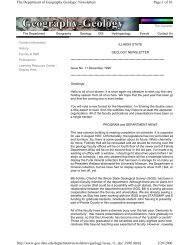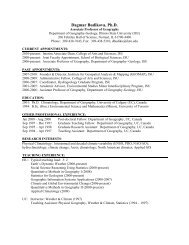04-1931 Geology Contact - Department of Geography - Geology
04-1931 Geology Contact - Department of Geography - Geology
04-1931 Geology Contact - Department of Geography - Geology
You also want an ePaper? Increase the reach of your titles
YUMPU automatically turns print PDFs into web optimized ePapers that Google loves.
Newsletterfor alumni <strong>of</strong> thegeology program atIllinois State UniversityAPRIL 20<strong>04</strong>Message fromthe chairpersonGreetings from the<strong>Department</strong> <strong>of</strong> <strong>Geography</strong>-<strong>Geology</strong>! I hope that at thebeginning <strong>of</strong> 20<strong>04</strong> you arein sound health and goodspirit.The uncertain budgetsituation and facultyturnover, especially on the geography side, continuedto be major issues in 2003 for the department.In May, Rina Ghose resigned to join the faculty atthe University <strong>of</strong> Wisconsin-Milwaukee. In December,Paul Anderson retired with plans to devote themajority <strong>of</strong> his time in the coming years to advancinghis work in Mozambique.One faculty search was initiated this year, andI am pleased to announce it was just successfullycompleted. Because we have three vacant positions,our needs were many. We prioritized physical/environmentalgeography in the hope <strong>of</strong> finding an individualwho would contribute to all three programsthat our department <strong>of</strong>fers. Amy Bloom (ABD, University<strong>of</strong> Utah) was the unanimous top choice <strong>of</strong>our department, and we are delighted that she hasaccepted our <strong>of</strong>fer and will join our department inthe fall. Her expertise is in limnology, climatology,and biogeography. She is a native <strong>of</strong> Park Forest,Illinois. She received her B.S. from Augustana beforeleaving for Utah. Her research involves studyingdiatoms in the alpine lakes <strong>of</strong> the Sierra Nevadato infer past limnological and climatologicalconditions.The budget situation in 2003 continued to beunpredictable, but it has turned out to be not as badas it has been in past years. Overall, the operatingbudget in the department and University contractedagain for the third straight year. At the departmentlevel, this has translated in a decline <strong>of</strong> 3.5 percentin state funding since the 2000-2001 academic year.The total amount <strong>of</strong> state funding for Illinois StateUniversity has declined more than 10 percent overthis time. Our central administration has done anexcellent job <strong>of</strong> protecting academic units from thebulk <strong>of</strong> the cuts, but the cuts have still hurt manyimportant student services. At the department level,we have managed to make up for our shortfall byaggressive pursuit <strong>of</strong> external funding, and by partneringwith government agencies and industry. In2003 our department generated more than$150,000 in external funding, most <strong>of</strong> which directlysupports student research. The initiatives that wehave engaged in over the past several years arebeginning to bear fruit. Donations to the PowellFund also are up.During the past year, much <strong>of</strong> our efforts weredirected toward recruiting undergraduate majorsand graduate students. We earn our keep with ourservice to General Education. No matter where youare, geology programs are among the smallest attheir respective campuses, and much smaller thanour peers in biology, chemistry, or physics. Part <strong>of</strong>this is because courses in geology are lacking in allbut a very small percentage <strong>of</strong> Illinois high schools.Earth science is taught in most schools, but not ata level that attracts the attention to geology as a possiblemajor in college.Consequently, we have focused our efforts onthose students who are interested in geology asincoming freshman and transfers, and studentsfrom our General Education courses. One <strong>of</strong> theways we have addressed the latter is by setting uptwo scholarship programs, each <strong>of</strong> which isdesigned specifically for incoming students. Wealso are more actively engaged in recruiting in ourcourses by promoting geology as a fun, challenging,and rewarding major. Our efforts are beginning topay <strong>of</strong>f. During the past year, our number <strong>of</strong> majorsincreased from the mid 20s to about 40, whichincludes 12 freshmen. Our long-term goal is 50,so I hope that this upward trajectory continues.On a personal note, I have accomplished severalimportant goals this year. First and foremost, my airlineavoidance streak ended at about 12.5 years as Iboarded a plane for Seattle in November. I hornedmy way into the window seat coming and going.Needless to say, my neck hurt for the next week orso from taking advantage <strong>of</strong> the fantastic view.While in Seattle, Bryce Willems ’02, JasonThomason, M.S. ’00, and I took a day <strong>of</strong>f and drovecontinued on page 2
Mt. St. Helens in earlyNovember.Message… continued from page 1down to Mt. St. Helens. Our prospects <strong>of</strong> a goodview were pretty iffy to begin with. Clouds were lowand lots <strong>of</strong> fresh snow covered the road in. We werethe first car up the mountain that day, but as weneared the summit the clouds broke for a fantasticview. We took plenty <strong>of</strong> pictures, and took advantage<strong>of</strong> some short hikes and road cuts. When wearrived back at the hotel, I was chagrined to see thatthe flash card in my new digital camera had malfunctioned,and most <strong>of</strong> the pictures were notrecorded. Jason took a number <strong>of</strong> pictures too,but his camera was lost or stolen on his way home.Fortunately the memories are fresh.Finally, I decided to move into the 20th centuryin Structural <strong>Geology</strong>. I moved all <strong>of</strong> my lectures toPowerPoint, and relied heavily on CD-ROM andInternet technologies.I hope that for each <strong>of</strong> you 20<strong>04</strong> is anotherprosperous year and that you and your family enjoygood health. I invite you to visit the department thenext time you are in town so you can meet some <strong>of</strong>our new colleagues. I also encourage your feedbackabout the happenings in the geology program.Please feel free to contact me at dhmalon@ilstu.eduor (309) 438-2692. If you haven’t looked lately,please visit our departmental Web site atwww.geo.ilstu.edu/. In particular, I encourageyou to have a look at our photo gallery and takeadvantage <strong>of</strong> our weekly colloquia series.Dave Malone[Editor’s note: Readers will notice use <strong>of</strong> the firstperson“I” throughout the newsletter. That “I” isDavid Malone, who wrote most <strong>of</strong> the articles.]The <strong>Contact</strong>April 20<strong>04</strong> • Published annually • Volume 3, No. 1Illinois State University, <strong>Department</strong> <strong>of</strong> <strong>Geography</strong>-<strong>Geology</strong>, Campus Box 4400, Normal, IL 61790-4400Liz King is principal investigatoron successful NSF grantBy Liz KingIn July I heard from National Science Foundationthat we were awarded our grant submitted tothe Course, Curriculum, and Laboratory ImprovementProgram in the Division<strong>of</strong> Undergraduate Education. We were awarded$50,000 (with an equal match from the college)toward our proposal: integrating the petrographicmicroscope, cathodoluminescence, and digitalimage analysis into the undergraduate geology curriculum.What this really means is that we neededsome new petrographic microscopes and we hadto jazz up our proposal for NSF. The microscopesarrived in October and are greatly appreciatedalready.The concept behind this project is to not onlyintroduce optical mineralogy in my mineralogycourse using modern microscopes, but to continueto use petrography in petrology, the two sedimentarycourses, paleontology, and structure. Cathodoluminescencewill be used in these courses as well,with an emphasis on carbonates. This will give thestudents an excellent opportunity to use the newestequipment availablefor the classroom,becomeinvolved inresearch involvingpetrography, andgain skills thatweren’t possiblebefore this grant.The classroomhas been transformeddrastically,Liz King and students are studyinga granite thin section using thenewly obtained petrographic/imaging equipment.not just because we have six new microscopes sittingin there. Each scope has a digital camera withlive video feed to a monitor. I can also use this forteaching optics, which has been fantastic. Studentswork in groups with everyone seeing the image onthe monitor. Using microscopes is no longer anactivity in isolation. Groups also can capture imageswith the digital camera and put together a Power-Point presentation from the lab. The group workand weekly student presentations throughout thesemester have led to camaraderie that usuallywasn’t reached until the end <strong>of</strong> spring semester.The scopes will be integrated over the next fewyears into the core courses <strong>of</strong> our major, but theyare making a great impact even in the short eightweeks <strong>of</strong> their use so far.2
Undergraduate program updateOur undergraduate program enjoyed anotheryear <strong>of</strong> stability. We added a course in hydrology,which is taught by Eric Peterson, as an elective tothe graduate and undergraduate programs.Field camp was run much as it has been thepast two summers. In 2003, Bill Shields and Itaught the first half in Wyoming. We were joinedby Mark Fischer from Northern Illinois University(NIU). This marked the ninth year that Mark and Ihave taught camp together. In South Dakota, Skipand TA Tim Sickbert handled the second half withLinda Davis, a visiting assistant pr<strong>of</strong>essor fromNIU. We had 11 students participate and NIU hadsix, including three that were from other universities.Last year’s camp was relaxing and enjoyable.The students were very hard working, and therewere no distractions provided by late season blizzards,bears, or an enraged mother moose. Thebody and soul cleansing in the Thermopolis HotSprings was as relaxing and enjoyable as ever. Asan added perk, students were permitted to do anevening reconnaissance <strong>of</strong> the Dead Indian HillProject in the Absaroka Range on horseback.Two <strong>of</strong> our traditional field areas in SouthDakota, Crook City and Whitewood Peak, continueto enjoy development. In 20<strong>04</strong> we plan toreplace the Crook City project with a small fold inthe Big Horn Basin <strong>of</strong> Wyoming. Thus, for the firsttime in the history <strong>of</strong> our field camp, time spent inWyoming will exceed that spent in South Dakota.Eight people joined the ranks <strong>of</strong> Illinois StateUniversity geology undergraduate alumni in 2003.They are June Clevy, Suzy Moore, Jake Morris,Scott Perkins, Liz Pigg, Brian Schmidt, AnnetteSmith, and Jennifer Thudium.Liz Pigg was selected as the 2003 LathropAward winner. The Lathrop Award is given annuallyto the top student each in geography andgeology who have strong records <strong>of</strong> leadership,scholarship, and financial need. The LathropAward is in honor <strong>of</strong> Harry O. Lathrop, a pr<strong>of</strong>essorin the department during the 1930s and1940s. An endowment set up in Lathrop’s honorprovides a $300 stipend for the award recipient.Two new scholarship programs that are aimedat recruiting students have been developed. Oneis the Wallen Award, set up in tribute to CharlenaWallen, the late wife <strong>of</strong> Felmley Building Servicesworker Don Wallen. This $250 award is givento a top incoming transferstudent, which in 2003was Lara Harlan.The other is theWatterson Award, whichis in tribute a former chair<strong>of</strong> the department, ArthurWatterson. This $250award is given to a topincoming freshman, whichin 2003 was Morgan Otto.Jed Day with studentsobserving Pennsylvanianstrata at Wyoming Hillon the Stratigraphy/Paleontology trip to Iowa.Field camp students John McEvoy,Sarah Rittenhouse (center) andLaura Crause debate the stratigraphy<strong>of</strong> the Triassic ChugwaterFormation at the Bud Love WinterGame Refuge northwest <strong>of</strong> Buffalo,Wyoming.On the fall structure field trip to the Baraboo, Wisconsin,area, we were able to visit the Denzer Quarry for the firsttime in several years. The disharmonic fold at the eastend <strong>of</strong> the quarry is still there in all <strong>of</strong> its glory.Liz King and Josiah Ballstudy a tuff outcrop atthe Johnson’s Shut-InsState Park on the Petrologytrip to Missouri.GEO 203students atSandy FordNature PreserveinOctoberGroup photograph<strong>of</strong> GEO290 class ontop <strong>of</strong> thewest bluff <strong>of</strong>Devils Lake,Wisconsinin October.3
Jed Day and colleaguesready to board a helicopterfor a field excursion.Jake Morris is at far left.Jed is in the center.Day receives grant from thePetroleum Research FundPr<strong>of</strong>essor Jed Day with Dr. Mike Whalen <strong>of</strong> theUniversity <strong>of</strong> Alaska-Fairbanks is in year two <strong>of</strong> aproject entitled “Integrated Late Devonian EventStratigraphy, Western North America” funded forthe amount <strong>of</strong> $80,000 from the PetroleumResearch Fund <strong>of</strong> the American Chemical Society.They are developing detailed fossil data (conodontsand brachiopods) from numerous field sitesin and around Jasper National Park and Crownlands (Alberta Provincial lands) in western Albertaand eastern British Columbia. They will developdetailed age correlations between Middle and LateDevonian sea level events that controlled the timing<strong>of</strong> deposition <strong>of</strong> the main reef Devoanian buildupsand nearby carbonate shelf successions. They alsowill develop the timing <strong>of</strong> stepped extinction eventsculminating in the Late Devonian Mass Extinction.The researchers are also developing detailedmagnetic susceptibility (MS) records to documentassociated climate changes. In addition, they willproduce carbon and oxygen stable isotopic datafrom sampled brachiopod skeletal calcite and conodontapatites to identify and correlate stable isotopeevents. The purpose <strong>of</strong> that is to study secularchanges in near equatorial sea surface or upperwater mass temperature to assess climate changesin the Devonian tropical ocean.In 2003 Jake Morris participated in field operationsin the Jasper Park and the Cadomin areas,with field operations planned in the Kakwa Parkarea <strong>of</strong> eastern British Columbia for the summer<strong>of</strong> 20<strong>04</strong>.New continuing educationpartnership with IEPAOne important new initiative this year was thedevelopment <strong>of</strong> a continuing education partnershipwith the Illinois Environmental Protection Agency(IEPA). Led by IEPA scientist Sherry Otto ’79 thispartnership was set up to train IPEA personnel inthe regional geology <strong>of</strong> Illinois through field tripsto various parts <strong>of</strong> the state, and through specializedfield, laboratory, lecture, and workshop coursesin environmental geology and hydrogeology. In2003-20<strong>04</strong>, our department will receive $25,000to develop these courses.This year is the first in what promises to be along-term mutually beneficial partnership. The first<strong>of</strong> these courses was a run to LaSalle County inNovember. Skip, Bill, and I led about 30 IEPA pr<strong>of</strong>essionalson a two-day field trip that highlightedthe local geology.Additional courses are planned. One that I amlooking forward to is inviting IEPA scientists alongon the stratigraphy field trip to Western Illinois inApril. As in past years, we will spend two days inthe Barnes Hill area. This year though, IEPA peoplewill be teamed up with stratigraphy students tomeasure and describe sections and make the geologicmap. I hope our students will make some valuablecontacts, and that the IEPA people will benefitfrom the student energy and enthusiasm.Illinois State University developspartnership with NICOR Inc.One <strong>of</strong> the exciting new partnerships that wedeveloped this year is with NICOR Inc. NICOR is amajor natural gas provider in Northern and CentralIllinois. The company operates a number <strong>of</strong> undergroundstorage fields along the LaSalle AnticlinalBelt and elsewhere in the state. The natural gas isextracted from natural reservoirs in the Gulf Coastarea, and shipped by pipeline to Illinois. Duringthe summer months, gas is pumped back into theground to store for use in the winter heating season.Because <strong>of</strong> increasing demand, the size <strong>of</strong> some <strong>of</strong>the storage fields will need to increase. A morethorough geologic and hydrogeologic understanding<strong>of</strong> these fields is needed.Through the efforts <strong>of</strong> Art Sanders ’96 we developeda NICOR-funded research project for LaurenHunt, a current master’s student, which involvesdetermining the nature <strong>of</strong> gas loss within the TroyGrove Gas Storage Field in LaSalle County. The loss<strong>of</strong> gas is estimated to be about 2 percent per year.Gas may have migrated to other parts <strong>of</strong> the structureor to the overlying quaternary deposits. Itmay dissolve in the groundwater, or it may be lostthrough equipment problems. Lauren’s work willinclude shallow geophysical imaging, and numericaland analytical models to address these hypotheses.4
Powell fund updateDuring these tight budget times, your generousdonations are most appreciated. The followingindividuals and groups contributed to the departmentalendowment in 2003.American Association <strong>of</strong>Petroleum GeologistsAnonymousSteven BaumanWade BoringDr. and Mrs. James CarterFaith FieneShannon FultonMary Heitmeyer and husbandMr. and Mrs. John KapchinskeDrs. Elizabeth and Andrew KingMr. and Mrs. James KippCynthia LampeMr. and Mrs. Peter LennarsonJames MacKeyMr. and Mrs. Ge<strong>of</strong>frey MadduxDr. and Mrs. David MaloneMr. and Mrs. Robert NorthMr. and Mrs. NottMr. and Mrs. Harold OrndorffDr. and Mrs. Stanley PaxtonMr. and Mrs. MichaelRowlandsMr. and Mrs. Douglas ShuttEdward SmithNancy TaylorMr. and Mrs. John TraubMr. and Mrs. WayneVogelsburgMr. and Mrs. Charles WilliamsAs you may know, Illinois State University isin the final stages <strong>of</strong> our first comprehensivecampaign, Redefining “normal”, which formallyends December 31. This is the first such campaignthat our University has enjoyed, and thereturns have been fantastic. We have succeededin generating more than $78 million in gifts, andwe are approaching our goal <strong>of</strong> $88 million.Although much <strong>of</strong> this money has come fromindividual donors, a significant amount has comefrom corporations in the form <strong>of</strong> “in kind” gifts,employee matches, and outright donations. Ifyour company has such policies in effect, andyou are willing to pursue ways in which ourdepartment can benefit, by all means let meknow.Graduate program updateAs noted in last year’s edition <strong>of</strong> The <strong>Contact</strong>,the hydrogeology program is in the process <strong>of</strong> aninterim program review. Hopefully the decision tocontinue the program will be made by the timethis issue <strong>of</strong> The <strong>Contact</strong> reaches your mailbox.Last year I summarized the argument to continuethe program. In December, Loren Raymond, apr<strong>of</strong>essor and former chair at Appalachian StateUniversity in North Carolina served as an externalconsultant to the program. His report, which canbe found on our Web site, was very supportiveand favorable.No other university in Illinois <strong>of</strong>fers a graduatedegree in hydrogeology. Five others <strong>of</strong>fer graduatedegrees in geology and students can elect tospecialize in hydrogeology (as well as other subdisciplinesin geology) at four <strong>of</strong> these institutions.Sixteen students are enrolled in our graduateprogram. Compared to peer institutions, we havemore hydrogeology graduate students than anyoneelse, and nearly as many as the other state-supportedgraduate programs combined. We are theschool <strong>of</strong> choice for Illinois residents who seek agraduate degree in hydrogeology. Thirteen <strong>of</strong> ourcurrent students come from Illinois. We are theonly graduate program in the state that does extensiveapplied hydrogeologic research in Illinois. Weare the only program with a dedicated instructionaland research well field. This is evident by theclose relationship that we have developed with theIllinois State Geological Survey (ISGS), whose missionit is to learn more about the geology <strong>of</strong> thestate. In FY03, Skip Nelson and Dave Malone wereselected as recipients <strong>of</strong> the ISGS OutstandingCooperator Award for our various partnerships.In 2003, the National Groundwater AssociationDarcy Lecturer, and the AAPG distinguished lecturereach gave presentations at Illinois StateUniversity.Two student achievements are <strong>of</strong> note. TimSickbert won the Arthur D. Howard award for thebest student research proposal from the Quaternary<strong>Geology</strong> and Geomorphology Division <strong>of</strong> theGeological Society <strong>of</strong> America. This award carrieda stipend <strong>of</strong> $5,000, and the award was presentedat the division business meeting at the Seattle conference.Tim also received a $500 grant fromSigma Xi. Katie Dertz won the Illinois State UniversityGraduate Student Teaching Award for herperformance as a teaching assistant for Principles<strong>of</strong> <strong>Geology</strong> course. Way to go Tim and Katie!In terms <strong>of</strong> curricular development, we are inthe process <strong>of</strong> developing a graduate-level coursein isotope geochemistry, which is scheduled to betaught this coming fall. This course will be teamtaughtby Liz King and Steve Van der Hoven.Two students earned their M.S. degrees thisyear: Deborah Opokuah and Brian Smith. Deborahis now pursuing a Ph.D. degree at the University<strong>of</strong> Indiana. Brian accepted a position withDelta Environmental in St. Charles, Missouri. Inthe eight years <strong>of</strong> the existence <strong>of</strong> the program,we have seen 41 students graduate. We are righton target <strong>of</strong> graduating an average <strong>of</strong> five studentsper year.5
“Thumper” vehicle as part<strong>of</strong> P-Wave seismic surveynear Fisher in June.Cooperative efforts with theISGS continue to expandIn the last two issues <strong>of</strong> The <strong>Contact</strong>, I reportedon the wonderful partnerships that we developedwith the Illinois State Geological Survey (ISGS), in2003 both the geophysics and the geochemistryprojects continued. The ISGS supported our studentswith more than $80,000 in grant moniesfrom their Illinois Board <strong>of</strong> Higher EducationWorkforce Development Program.The Geophysics project fully funded yearlongresearch assistantships for Bryce Willems and JenniferMurphey. Their work was further supportedby our sixth grant from the U.S. Geological SurveyEDMAP program. Together, these projects support3-D geological mapping, and the delineation <strong>of</strong> apoorly constrained buried bedrock valley as apotential aquifer.The ISGS support this year included summersalaries for eight graduate and undergraduatestudents who assisted in well drilling and seismicdata acquisition. Preliminary results indicate thatthe Ticona Channel is wider than originallythought, and it has well-developedterraces. One exploration well wasdeveloped about a mile from the VermilionRiver, which incises channel-fillsediments. This well revealed about20 feet <strong>of</strong> unsaturated sand more than120 feet below the surface at the top <strong>of</strong>Graduate Student BryceWillems recording newlyacquired seismic data.Geophysics field partysetting up a geophonestream in LaSalle County.channel-fill sediments. Furthermore, the headdirectly varied with the stage <strong>of</strong> the VermilionRiver, which indicates a significant hydrologicconnection.The geochemistry project enjoyed its secondand final year. This year, three students attemptedto determine whether or not coal mining left adefinitive signature in stream sediment geochemistry.Chemical analysis <strong>of</strong> sediment samples isongoing.A third and potentially significant project wasinitiated in 2003, and was spearheaded by AssistantPr<strong>of</strong>essor <strong>of</strong> <strong>Geography</strong> Dagmar Budikovaand graduate student Sarah Rittenhouse. Thisproject initially involved a geostatistical analysis<strong>of</strong> oil and gas reservoirs in the Illinois Basin. InAugust, the ISGS was awarded a $2 million grantfrom the U.S. <strong>Department</strong> <strong>of</strong> Energy to study thefeasibility <strong>of</strong> the geologic sequestration <strong>of</strong> CO 2,a major greenhouse gas, in structures. The ISGSawarded our department a subcontract in theamount <strong>of</strong> $18,000 in 20<strong>04</strong> to continue her work.This is on top <strong>of</strong> $12,000 awarded to her in 2003.Students log core from an exploratorywell to ground truth seismic data.Emeritus faculty updateDick Hart is well and still living in Normal. Hevisited the department in early February and hopesto make visiting more <strong>of</strong> a habit. Tom Searight hasleft Lawrence, Kansas, and moved down the roadto Overland Park, a suburb <strong>of</strong> Kansas City. Theymoved to get a bit closer to their daughter andson-in-law and to escape a neighborhood that wasslowly being invaded by KU students. As I write,I am confident that Jim Kirchner is in Florida, andI hope on a sailboat. Bob Corbett is still very activein AIPG and NAGT, and each fall he finds time toteach a section or two <strong>of</strong> Foundations <strong>of</strong> Inquiry.6
Dan Wendell Delivers2003-20<strong>04</strong> Foster LectureOn February 20, 20<strong>04</strong>, DanWendell ’80 gave the fifth annualJohn W. Foster HydrogeologyLecture. His talk “Money forWater, Money for Peace, Waterfor Peace: The Politics and Science<strong>of</strong> Water in the West Bankand Kazakhstan,” attracted about 70 participantsfrom across campus. While here, he also gave atechnical talk on groundwater modeling to SteveVan der Hoven’s Contaminant Transport class, andhe talked with our undergraduate students aboutcareer opportunities in the geosciences.Dan graduated with a B.S. in geology from IllinoisState University. He then obtained M.S. degreesin geology and hydrogeology from the University <strong>of</strong>Nevada at Reno, during and after which he workedin the mineral exploration, environmental, andwater resources industries. This work has includedemployment with both the public sectors (at acoastal California water agency) and private sectors(Anaconda Minerals, Dames & Moore, CH2MHILL). For the past 13 years Dan has beenemployed with CH2M HILL in three different California<strong>of</strong>fices, and now serves as senior hydrogeologist,project manager, and lead client service managerfor CH2M HILL’s San Francisco <strong>of</strong>fice.Dan specializes in water resource analysis andconstruction <strong>of</strong> high-capacity municipal water supplywells, injection wells, and dual-purpose injection-extraction“Aquifer Storage and Recovery”(ASR) wells. He has developed 3-D groundwaterflow models <strong>of</strong> numerous basins in California, aswell as basins in England and Kazakhstan. He hashelped evaluate and design numerous small-scaleand basin-wide conjunctive use projects that utilizepotable and/or reclaimed water and worked on theseawater injection barrier that protects the coastalbasins <strong>of</strong> Los Angeles. He is evaluating potentialland subsidence issues in San Francisco areagroundwater basins, an issue too <strong>of</strong>ten neglected.Dan has also evaluated numerous contaminantsites, including VOC Superfund sites, perchloratecontamination, and chromium contamination. Heis working on the “Hinkley” site, made famous bythe movie Erin Brockovich.Dan has worked extensively throughout thewestern United States, and also in England, theWest Bank, and Central Asia. At Illinois State he discusseda groundwater development project he managedin the West Bank and a well rehabilitationeffort near the Aral Sea in Kazakhstan, a formermember <strong>of</strong> the Soviet Union.Our department regularly runs a fantasticcolloquia series, which usually occurs on Fridayafternoons at 3 o’clock. In addition to the FosterLecturers, we have had other notable guests, includingthe AAPG Distinguished lecturer and GSA DarcyLecturer. These events are open to the public, and alisting <strong>of</strong> upcoming presentations can be found atwww.geo.ilstu.edu/events/Geoschedule.shtml.I encourage you to attend.Alumni newsHere are the happenings for some <strong>of</strong> yourfellow alumni. As in recent years, this listing isheavily skewed to our recent graduates. We wouldlove to learn <strong>of</strong> the happenings in your life. Pleasefill out the card on the outside <strong>of</strong> the newsletterand send it back.Tim Greetis ’80 has taken a position with DirectPush Analytical Corp. located in Lawrenceburg,Indiana (suburb <strong>of</strong> Cincinnati, Ohio). His companyprovides Geoprobe and mobile laboratory servicespredominantly to environmental consultants.Gary Carnaghi ’80 is still working as an independentpetroleum geologist in Tulsa, Oklahoma.During the fall, he stopped by to teach a lecturein Skip Nelson’s geomorphology class.Tony Swierczek ’02 is working for Delta Environmentalis St. Charles, Missouri.Steve Williamson ’00 and Brett Naugle ’88work as geologists for Mauer Stutz, Inc. in Peoria.Andy Maas ’01 is nearing completion <strong>of</strong> his M.S.degree at LSU and has accepted a position atExxon Mobil.Steve Johnson ’97 has returned to our Hydrogeologygraduate program.Kevin Schnoes ’88 is director <strong>of</strong> research, planningand development for the City <strong>of</strong> Chicago<strong>Department</strong> <strong>of</strong> Solid Waste and TechnicalServices.Heather (Miller) Perry ’00 is a staff hydrologistfor Handex in Tallahassee, Florida.Jim Tate ’02 is working for Superior Environmentalin Dixon.Tom Feehan ’94, M.S. ’96, is still working forWater Management Consultants but they havemoved the <strong>of</strong>fice to Reno, Nevada.Sherry Otto ’79, Jeff Guy ’95, and Paula Stine’97 are working for the IEPA in Springfield.Heidi Dowd ’00 has finished her M.S. degreein sedimentology/stratigraphy at the University<strong>of</strong> Iowa, and is now in Houston, Texas workingfor Exxon-Mobil.Eric Wright ’00, M.S. ’02, has accepted a job as ahydrogeologist at Arcadis in Mahwah, New Jersey.2003 B.S. graduates who have gone on to graduateschool are Liz Pigg (University <strong>of</strong> Missouri),June Clevy (University <strong>of</strong> Idaho), Annette Smith(University <strong>of</strong> Wyoming), and Suzy Moore(Colorado State University).7
We welcome your supportSend us your newsI want to support quality education in the<strong>Department</strong> <strong>of</strong> <strong>Geography</strong>-<strong>Geology</strong>.NameMailing addressCity State Zip( )Daytime telephoneE-mailEmployerWe want to hear from you and about you! Please fill outthe form and mail to Illinois State University, <strong>Department</strong> <strong>of</strong><strong>Geography</strong>-<strong>Geology</strong>, Campus Box 4400, Normal, IL 61790-4400.NameGraduation yearMailing addressDegree(s)City State ZipNews and commentsYour positionMake your check payable to Illinois StateUniversity Foundation and mail to Illinois StateUniversity, <strong>Department</strong> <strong>of</strong> <strong>Geography</strong>-<strong>Geology</strong>,Campus Box 4400, Normal, IL 61790-4400. Ifyou want your entire contribution to supportthe department, write “Powell Fund” on thememo line <strong>of</strong> your check.An equal opportunity/affirmative action university encouraging diversity UNIVERSITY MARKETING AND COMMUNICATIONS <strong>04</strong>-<strong>1931</strong> printed on recycled paper with soy ink<strong>Department</strong> <strong>of</strong> <strong>Geography</strong>-<strong>Geology</strong>Campus Box 4400Normal, IL 61790-4400Nonpr<strong>of</strong>it Org.U.S. PostageP AIDIllinois StateUniversity


